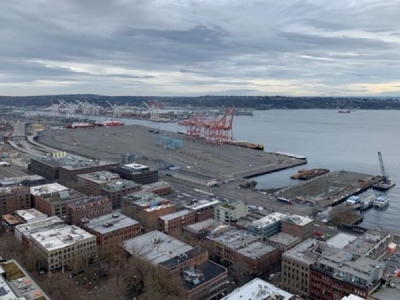
Posted on March 16, 2020
In what is being called a “once-in-a-generation investment,” the Port of Seattle will spend $9.5B to make capital improvements at the Seattle-Tacoma International Airport and its marine terminal facilities over the next decade.
“This is a testament to the growth of the region,” Port of Seattle Managing Director of Economic Development David McFadden said. McFadden will be one of the panelists at Bisnow’s Seattle Construction & Development event March 31.
The growth is staggering. Seattle’s population grew by 136,000 people since 2010, a 22% increase in a decade. The city’s population hit 745,000 in 2018, according to The Seattle Times. While the city of Seattle swells, the population of the Puget Sound region explodes as well. It is currently adding 188 people a day, which equates to more than 500,000 new residents since 2010.
“These improvements provide the region the capacity to grow and perform economically and support a tremendous amount of commerce,” McFadden said.
Colliers Executive Vice President Matt McGregor agrees.
“It is imperative that the Northwest Seaport Alliance continues to make innovative investments in an effort to remain competitive and be a reliable port system for industrial commerce,” he told Bisnow. “The Alliance is currently the fourth-most-active port system in the United States, and with many other port systems making significant investments, the Alliance is making the right moves to stay on the cutting edge.”
The Port of Seattle is the parent organization of the Northwest Seaport Alliance, which is composed of both the Seattle and Tacoma ports. Combined, the port authority is the third-largest cargo port in the United States by container volume.
The region’s economy has been booming for the last decade, but McFadden acknowledged the recent novel coronavirus outbreak may have an impact on the port’s development plans. Though the port’s plans are long term, the unknown makes it difficult to predict.
“There is uncertainty over our operations,” he said. “It’s a cloud we can’t see through. This will pass, but there is an uncertainty about when or how. This virus is certainly a potentially game-changing event.”
If all goes as planned, the improvements will include $200M for a new cruise berth, which assumes a 50% tenant cost share, $39M for development of Terminal 91, $35M for berth replacement at Terminal 91, $30M to bring electrical power to the waterfront, $23M for Fisherman’s Terminal Gateway Building, $17M for a Terminal 117 habitat restoration program and $10.5M for a maritime innovation center.
At Sea-Tac, some of the projects include the modernization of the North Satellite, the improvement of the international arrivals facility and remodeling of dining and retail areas, which is set to be complete by 2024. In addition, a $17M project will add 10K SF of shops and restaurants to Central Terminal. The Concourse D Annex is complete, as are a center runway reconstruction and a centralized pre-conditioned air plant.
The port is also looking for sites to build another airport. Fifty million people use the airport every year and it will eventually run out of capacity, McFadden said.
“It will take 10 or 20 years to develop a parallel airport,” he said. “We have a growing traveling public and we are making those investments that will sustain our cargo industry, as well as investing in new cruise terminals, which is born out of the growth of that industry.”
Source: bisnow.com





